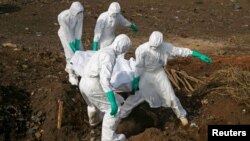A new study concludes that a tiny minority of so-called “superspreaders” was likely responsible for the lethal Ebola epidemic in West Africa.
Researchers at Princeton University in New Jersey and Oregon State University found that 3 percent of infectious individuals with Ebola were the source for more than 61 percent of all cases.
The findings were published in the journal Proceedings of the National Academy of Sciences.
According to the World Health Organization, more than 28,000 cases of the viral infection were reported between October 2014 and March 2015, resulting in more than 11,000 deaths.
Using a mathematical model, the investigators went back and analyzed 200 burials in and around Freetown, Sierra Leone's capital. From this, researchers reconstructed a transmission network looking at what proportion of infected individuals were superspreaders.
Superspreaders profiled
The authors said the superspreaders were most likely children younger than 15, and adults older than 45, caretakers who tended to the sick at home and became infected, then continued to spread the disease to others.
Researchers say this driving force was also responsible for the Ebola epidemic in Guinea and Liberia, the other West African countries hard hit by the disease.
The illness was spread through contact with infected bodily fluids of the sick. Another source of infection, researchers found, were community funerals where loved ones touched and bathed the bodies.
Had these superspreaders been identified early and treated at community health facilities with infection-control procedures, the epidemic may have been contained.
Not a new idea
The authors of the study say public health officials should concentrate on superspreaders in future epidemics to limit transmission.
The concept of superspreading is not new and played a role in the SARS epidemic in Asia in 2002-03. The Washington Post reported that one man admitted to a hospital infected 156 clinical staff and visitors. The disease, marked by trouble breathing, high fever and cough, was responsible for 40 percent of deaths in more than two dozen countries.
The most famous superspreader was Typhoid Mary, who was thought to have transmitted the disease to 50 other people, three of whom died. The transmissions occurred in New York City, in the early part of the 20th century.







